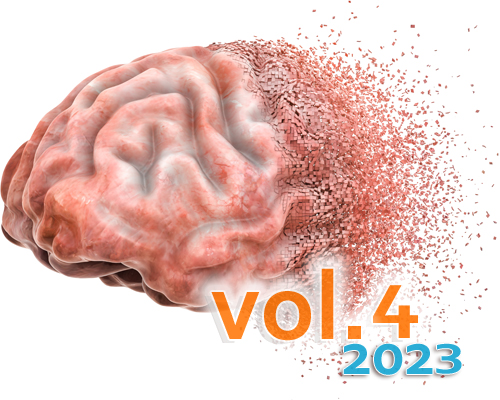Golgi localization of SARS-CoV-2 spike protein and interaction with furin in cerebral COVID-19 microangiopathy: a clue to the central nervous system involvement?
DOI:
https://doi.org/10.17879/freeneuropathology-2023-4584Keywords:
COVID-19, Neuro-COVID, Microangiopathy, Furin, Blood-brain barrier (BBB)Abstract
In a neuropathological series of 20 COVID-19 cases, we analyzed six cases (three biopsies and three autopsies) with multiple foci predominantly affecting the white matter as shown by MRI. The cases presented with microhemorrhages evocative of small artery diseases. This COVID-19 associated cerebral microangiopathy (CCM) was characterized by perivascular changes: arterioles were surrounded by vacuolized tissue, clustered macrophages, large axonal swellings and a crown arrangement of aquaporin-4 immunoreactivity. There was evidence of blood-brain-barrier leakage. Fibrinoid necrosis, vascular occlusion, perivascular cuffing and demyelination were absent. While no viral particle or viral RNA was found in the brain, the SARS-CoV-2 spike protein was detected in the Golgi apparatus of brain endothelial cells where it closely associated with furin, a host protease known to play a key role in virus replication. Endothelial cells in culture were not permissive to SARS-CoV-2 replication. The distribution of the spike protein in brain endothelial cells differed from that observed in pneumocytes. In the latter, the diffuse cytoplasmic labeling suggested a complete replication cycle with viral release, notably through the lysosomal pathway. In contrast, in cerebral endothelial cells the excretion cycle was blocked in the Golgi apparatus. Interruption of the excretion cycle could explain the difficulty of SARS-CoV-2 to infect endothelial cells in vitro and to produce viral RNA in the brain. Specific metabolism of the virus in brain endothelial cells could weaken the cell walls and eventually lead to the characteristic lesions of COVID-19 associated cerebral microangiopathy. Furin as a modulator of vascular permeability could provide some clues for the control of late effects of microangiopathy.
Metrics
Additional Files
Published
How to Cite
Issue
Section
License
Copyright (c) 2023 Susana Boluda, Karima Mokhtari, Bruno Mégarbane, Djillali Annane, Bertrand Mathon, Albert Cao, Clovis Adam, Alexandre Androuin, Franck Bielle, Guy Brochier, Frédéric Charlotte, Lydia Chougar, Khalid Hamid El Hachimi, Marc Eloit, Stéphane Haïk, Dominique Hervé, Amal Kasri, Valentin Leducq, Stéphane Lehéricy, Etienne Levavasseur, Christian Lobsiger, Geoffroy Lorin de La Grandmaison, Isabelle Malet, Isabelle Malissin, Stéphane Marot, Serge Marty, Philippe Pérot, Isabelle Plu, Annick Prigent, Lev Stimmer, Marie-Claude Potier, Anne-Geneviève Marcelin, Benoît Delatour, Charles Duyckaerts, Danielle Seilhean

This work is licensed under a Creative Commons Attribution 4.0 International License.
Papers are published open access under the Creative Commons BY 4.0 license. This license lets others distribute, remix, adapt, and build upon your work, even commercially, as long as they credit you for the original creation. Data included in the article are made available under the CC0 1.0 Public Domain Dedication waiver, unless otherwise stated, meaning that all copyrights are waived.



















